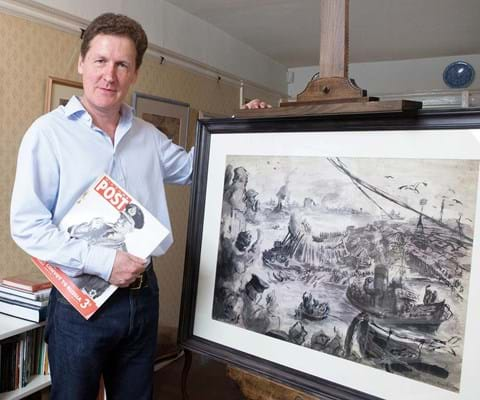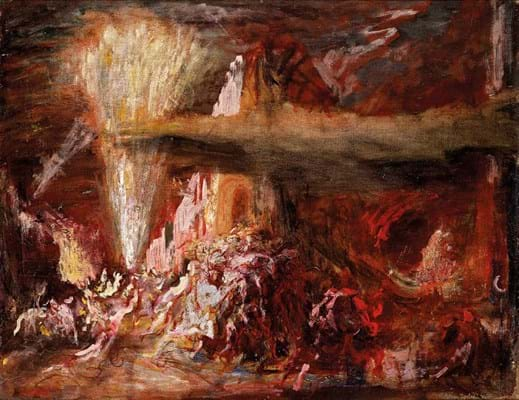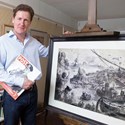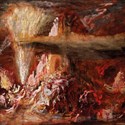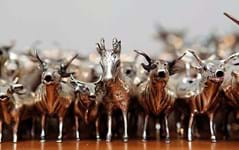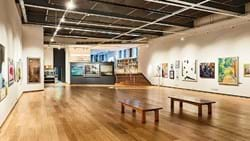Trawling through auction houses (the lower profile the better) for hidden gems of British art, researching them exhaustively and telling their stories to potential buyers: this is how Andrew Sim sums up his work.
While talking to ATG, Sim expresses himself in a smiling but firm way. “If I discover an unknown picture of George Eliot in a provincial auction I deserve to be rewarded for it,” he says, referring to a c.1845 chalk pastel he found recently.
Sim turns a profit on such pieces by adding value through research, drawing out the narrative behind the work and, often, attaching a name to items before selling them on.
“It’s not a mark-up,” he adds. “I’m a sole trader doing my own thing, panhandling my way around the landfill sites trying to find treasures. That’s what really turns me on.”
It has not always gone smoothly. He admits that he has made expensive mistakes on individual pictures that have turned out to be fakes when he submitted them for inspection by experts, as is his regular practice. He sees these as necessary false steps in his education as a dealer, having a “suturing effect” on any tendency he might have had to spend high at auction. Now, he says, the pieces he goes for are “sleepers” in the truest sense of the word.
Media man
Comparatively new to the scene, Sim started out as a journalist and worked in the media before commencing a career buying and selling pictures in the mid-2000s.
From his first days as a dealer, he saw illustrative captions as a key piece of the practice: not only do the stories fascinate him, they help draw in new clients, especially those potential buyers who are not indoctrinated into the art world.
At Sim’s earliest fairs the labels against his offerings were almost comically long. These days he regulates the word count, but he is still driven to tell the stories of his works which span from the Battle of Trafalgar to the close of the Second World War.
At the upcoming 20/21 British Art Fair, he will feature a number of works by Feliks Topolski (1907-89). The Polish-born artist, who moved to the UK shortly before the Second World War, was commissioned by Kenneth Clark to record the effect of the Blitz on Londoners.
“I’ve always been on the investigating side and wanted to be a person doing my own thing
While sketching a bomb crater at the corner of Old Compton Street and Dean Street, Topolski was blown into the door of a shoe shop by another explosion 50 yards away. The scene was later worked up into Attack Monstre – Bombed in Soho.
The oil is one of the highlights of Sim’s stand at 20/21 BAF, which he will use to stage the 8th edition of his annual exhibition Drawing the Line: The Art of the War Years.
This year’s focus on Topolski is a direct result of the 2015 edition of 20/21 BAF, where Sim exhibited Germany Defeated, showing the last days of Hitler’s regime. It was bought by the Tate – improving its representation of the lesser-known artist.
This was a key moment for Sim, helping him cement his relationship with Topolski’s surviving family.
“I knew the family had these works for years but when I was just establishing myself they weren’t prepared to give me their crown jewels. When I got that work into the Tate, though, they were thrilled.”
And he hopes that at this show, Topolski works will find their way into other museums, the rightful place, he believes, for such powerful records of British life at war.
“20/21 is quite a catholic fair telling a complex story,” he says. “Twentieth century art turns out to be much more complicated than it might have seemed 10 years ago.”
Independent artists
He highlights this complexity by selling works, both at and outside the fair, by artists who were independent during war years, representatives of a “vernacular world”, as well as those official war artists who were “harnessed to the state”.
It means that, as he puts it, “a lot of my stuff is ugly. It’s pictures of people being retrieved from the field of battle, injured or dying.” He characterises such pieces as traditionally “uncommercial”. This is his sweet spot.
“I like to follow my own interests behind each piece. I’ve always been on the investigative side and wanted to be a person doing my own thing. I thought I could bring that to bear in the art world,” he says.
Sometimes, though, the artists he champions start being more accepted. Prices for them go up and their need for representation goes down. Sim is not interested in riding the waves of artists’ popularity. Though he is a great admirer of the works of William Nicholson and Christopher Nevinson, he categorises these artists now as out of his realm.
It is not just a matter of being conscious of his outlay. He also enjoys working on his own projects, so at the moment he is generally going for works with no names attached.
One find is a depiction of the son of Henry Taylor Coleridge, Hartley, by an unknown artist. Here, he says, his background gives him an edge: “How many dealers out there have an English degree and know who Hartley Coleridge is?
“Many dealers in this situation would do other things, look for what school the work is. I want to find the piece of the work that nobody knows about.”
The key, in other words, is being different and provocative. And for Sim, that is all in a day’s work.
Curriculum Vitae
2007
Started Sim Fine Art
2003-2007
Producer C4 Racing – dealing part-time
1999
Commissioning editor, Channel 4
1994
Journalist, MGN
1990
Architectural feature writer/editor
1987
Reporter, Time Out guide to London
1987
Postgraduate diploma in journalism, London
1986
Graduated with BA Hons in English literature from York University


